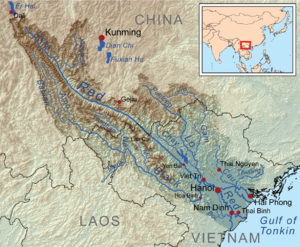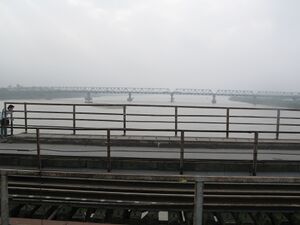النهر الأحمر (آسيا)
| Red River Hong River | |
|---|---|
 Red River in Yuanyang County/Gejiu City, Yunnan | |
 Red River and its tributaries. | |
| الموقع | |
| Country | China, Vietnam |
| Provinces | Yunnan Province (China), Lào Cai province, Yên Bái province, Phú Thọ province, Hanoi, Vĩnh Phúc province, Hưng Yên province, Hà Nam province, Thái Bình province, Nam Định province |
| السمات الطبيعية | |
| المنبع | |
| ⁃ الموقع | Hengduan Mountains, Weishan, Dali, Yunnan, China |
| ⁃ المنسوب | 1,776 m (5,827 ft) |
| 2nd source | |
| ⁃ الموقع | TBD, Xiangyun, Dali, Yunnan, China |
| المصب | Ba Lạt |
- الموقع | (boundary between Tiền Hải and Giao Thủy) |
- الإحداثيات | 20°14′43″N 106°35′20″E / 20.24528°N 106.58889°E |
- المنسوب | 0 m (0 ft) |
| الطول | 1,149 km (714 mi) |
| مساحة الحوض | 143,600 km2 (55,400 sq mi)[1] 169,000 km2 (65,000 sq mi)[1] |
| التدفق | |
| ⁃ الموقع | Red River Delta, Gulf of Tonkin, Vietnam |
| ⁃ المتوسط | 4,300 m3/s (150,000 cu ft/s)[1] |
| ⁃ أدنى تدفق | 1,200 m3/s (42,000 cu ft/s)[1] 700 m3/s (25,000 cu ft/s) |
| ⁃ أقصى تدفق | 35,000 m3/s (1,200,000 cu ft/s)[1] 9,500 m3/s (340,000 cu ft/s)[2] |
| التدفق | |
| ⁃ الموقع | Việt Trì |
| ⁃ المتوسط | 900 m3/s (32,000 cu ft/s) |
| سمات الحوض | |
| الروافد | |
| - اليسرى | Nanxi, Lô |
| - اليمنى | Đà |
النهر الأحمر (بالفيتنامية: Sông Hồng أو Hồng Hà، بالصينية: ت 紅河, ب 红河, پ Hóng Hé) هو نهر يتدفق من الصين مروراً بفيتنام حتى بحر الصين الجنوبي. كما يسمى أيضاً يوان جيانگ (بالصينية: 元江).
يبدأ النهر في مقاطعة يوننان بالصين. ويتدفق نحو جنوب الشرق مروراً بمناطق أقليات الداي قبل أن يغادر الصين عبر ولاية هونغه المستقلة ذاتياً في يوننان. يدخل النهر فيتنام خلال محافظة لاو كاي، ويمرّ في النهاية أمام الحافة الشرقية للعاصمة الفيتنامية هانوي. تقع تونكين على الدلتا النهرية. في الأيام الإستعمارية، حاولت السلطات الفرنسية وغيرها بجعل النهر الأحمر شرياناً تجارياً مع الصين، وقد نجح ذلك لفترة محدودة. إنّ النهر الأسود هو الرافد الرئيسي للنهر الأحمر.
الجغرافيا
The Red River begins in China's Yunnan province in the mountains south of Dali. Main headstreams Leqiu River, Xi River and Juli River confluence at Nanjian where they form the Lishe River. The Lishe River meets with another headstream, the Yijie River at Hongtupo, Chuxiong Prefecture. It flows generally southeastward, passing through Yi and Dai ethnic minority areas before leaving China through Yunnan's Honghe Autonomous Prefecture. It enters Vietnam at Lào Cai province and forms a portion of the international border between China and Vietnam. The river, known as Thao River for this upper stretch, continues its southeasterly course through northwestern Vietnam before emerging from the mountains to reach the midlands.[بحاجة لمصدر] Its main tributaries, the Black River (Da River) and Lô River join in to form the very broad Hồng near the city of Việt Trì, Phú Thọ province.
Downstream from Việt Trì, the river and its main distributaries, the Đuống River, Kinh Thầy River, Bạch Đằng River and the Thái Bình river system spread out to form the Red River Delta. The Red River flows past the Vietnamese capital Hanoi before emptying into the Gulf of Tonkin. Its estuary is an important Ramsar site and forms the main part of the Xuân Thủy National Park.
The reddish-brown heavily silt-laden water gives the river its name. The Red River is notorious for its violent floods with its seasonally wide volume fluctuations. Intense seasonal floods are made worse by erosion, development, and pollution. The delta is a major agricultural area of Vietnam with vast area devoted to rice. The land is protected by an elaborate network of dikes and levees.[بحاجة لمصدر]
ممر للسفر والنقل
In the 19th century, the Red River was thought to be a lucrative trade route to China. The late 19th-century French explorers were able to travel up the Red River until Manhao in South Yunnan, and then overland toward Kunming.[3]
The Red River remained the main commercial travel route between the French Indochina and Yunnan until the opening of the Kunming–Haiphong Railway in 1910. Although French steamers would be able to go as far upstream as Lao Cai during the rainy season,[4] during the dry season (November to April) steamship would not go upstream of Yên Bái; thus, during that part of the year goods were moved by small vessels (junks).[5]
Thanks to the river, Haiphong was in the early 20th century the sea port most easily accessible from Kunming. Still, the travel time between Haiphong and Kunming was reckoned by the Western authorities at 28 days: it involved 16 days of travel by steamer and then a small boat up the Red River to Manhao (425 miles), and then 12 days overland (194 miles) to Kunming.[5]
Manhao was considered the head of navigation for the smallest vessels (wupan 五版); so Yunnan's products such as tin would be brought to Manhao by pack mules, where they would be loaded to boats to be sent downstream.[4] On the Manhao to Lao Cai section, where the current may be quite fast, especially during the freshet season, traveling upstream in an wupan was much more difficult than downstream. According to one report, one could descend from Manhao to Lao Cai in just 10 hours, while sailing in the reverse direction could take 10 days, and sometimes as much as one month.[4]
السدود
Several hydroelectric dams have been constructed on the Red River in Yunnan:[6]
- Da Wan Dam
- Dachunhe I Dam
- Dachunhe II Dam
- Nansha Dam, near Nansha Town, Yuanyang County
- Madushan Dam, near Manhao Town, Gejiu City
Many more dams exist on the Red River's tributaries, both in Yunnan and in Vietnam.[6] One of the earliest of them is the Thác Bà Dam in Vietnam, constructed in 1972, which forms the Thác Bà Lake.[7]
المستوطنات
الصين (中國)
- Yunnan (雲南)
- Honghe (紅河)
- Nansha Town, the county seat of Yuanyang County, Yunnan (南沙鎮)
- Manhao Town (Gejiu County-level City) (蔓耗鎮)
- Hekou Yao Autonomous County (河口瑤族自治縣)
ڤيتنام (Việt Nam)
- Hà Nội
- Tây Hồ district
- Ba Đình district
- Hoàn Kiếm district
- Hai Bà Trưng district
- Long Biên district
- Gia Lâm district
- Hoàng Mai district
- Ba Vì district
- Đan Phượng district
- Đông Anh district
- Mê Linh district
- Phúc Thọ district
- Phú Xuyên district
- Sơn Tây town
- Thanh Trì district
- Thường Tín district
- Từ Liêm district
- Hà Nam province
- Hưng Yên province
- Lào Cai province
- Nam Định province
- Phú Thọ province
- Thái Bình province
- Vĩnh Phúc province
- Yên Bái province
انظر أيضاً
المراجع
- Administration, E., & Hogan, C. (2013). South China Sea. Retrieved from Encyclopedia of Earth
- earthtrends.wri.org, Water Resources eAtlas, Hong (Red River)
- ^ أ ب ت ث ج Bank erosion in Mekong Delta and Red River. March 2004. Archived from the original. You must specify the date the archive was made using the
|archivedate=parameter. https://www.researchgate.net/publication/294892187. - ^ "Red River | river, Asia | Britannica". www.britannica.com.
- ^ Bulletin of the Geographical Society of Philadelphia, 9-10, Geographical Society, 1912, pp. 18–20, https://books.google.com/books?id=DHBIAAAAYAAJ&pg=PA18
- ^ أ ب ت Little, Archibald John (1906), Across Yunnan & Tonking by Archibald Little: Part I. Between Two Capitals. Part II. Yunnanfu to the Coast, p. 26, https://books.google.com/books?id=TqE7Q8SwHcwC
- ^ أ ب Whates, H. (1901), The Politician's Handbook, Vacher & Sons, p. 146, https://books.google.com/books?id=R5tPAAAAMAAJ&pg=PA146
- ^ أ ب Commissioned, Under Construction and Planned Dams in April 2016 Archived 2017-04-06 at the Wayback Machine (WLE Greater Mekong)
- ^ Lu, Xi Xi; Oeurng, Chantha; Le, Thi Phuong Quynh; Thuy, Duong Thi (2015). "Sediment budget as affected by construction of a sequence of dams in the lower Red River, Viet Nam". Geomorphology. 248: 125–133. Bibcode:2015Geomo.248..125L. doi:10.1016/j.geomorph.2015.06.044.
وصلات خارجية
 Media related to Red River (Asia) at Wikimedia Commons
Media related to Red River (Asia) at Wikimedia Commons
الهامش
- C. Michael Hogan (2011) South China Sea Topic ed. P.Saundry. Ed.-in-chief C.J.Cleveland. Encyclopedia of Earth. National Council for Science and the Environment. Washington DC
- earthtrends.wri.org, Water Resources eAtlas, Hong (Red River)
وصلات خارجية
 Media related to Red River (Asia) at Wikimedia Commons
Media related to Red River (Asia) at Wikimedia Commons- song ma- Song Ma tinh Son La
- Pages using gadget WikiMiniAtlas
- Short description is different from Wikidata
- Articles with hatnote templates targeting a nonexistent page
- Missing redirects
- Coordinates on Wikidata
- Infobox mapframe without OSM relation ID on Wikidata
- Articles containing صينية-language text
- Articles with unsourced statements from August 2014
- النهر الأحمر (آسيا)
- أنهار يوننان
- أنهار هانوي
- Rivers of Hung Yen Province
- Rivers of Nam Dinh Province
- Rivers of Thai Binh Province
- Rivers of Lao Cai Province
- Rivers of Yen Bai Province
- Rivers of Phu Tho Province
- Rivers of Vinh Phuc Province
- Rivers of Ha Nam Province
- أنهار دولية في آسيا
- خليج تونكين
- China–Vietnam border
- أنهار آسيا
- جغرافيا الصين
- ڤيتنام
- صفحات مع الخرائط




